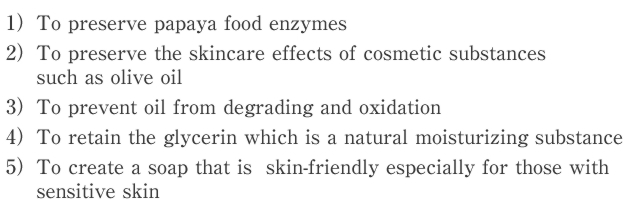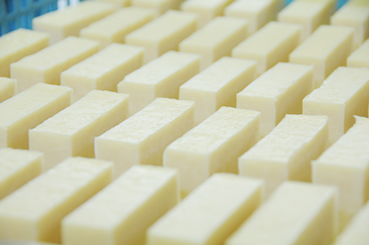Soap-making has two types of methods. The first one is called "saponification." Soaps made via saponification usually do not have additives added to them. The second one is called "neutralization." Neutralization is mainly used in the quick mass-production of soaps with the help of machines. Soap-making has also two different kinds of drying methods: "hot process", which is a common method of drying soaps with the use of heat, and "cold process", which does not use heat to dry soaps.
Saponification
Saponification is a method of making a base soap by mixing plant oils such as olive oil and sodium hydroxide (caustic soda) together and causes a chemical reaction. Saponification also involves the making of potassium soap, which is the base soap and is highly soluble in water, by mixing potassium hydroxide (caustic potash) and animal fat together and causes a chemical reaction. *Caustic soda or caustic potash is the essential main ingredients in soap-making. Especially in saponification, the soap does not virtually leave residues when naturally dried. The soap-making process also produces a by-product called glycerin, a substance isolated from animal fats.
Neutralization
Compared to saponification, "neutralization" involves in making soaps within a short period of time by isolating fatty acids and glycerin from animal fat and then followed by mixing fatty acids with nitrate. Making soaps via neutralization usually takes up to 3 to 4 hours, so it allows soap manufacturers to produce soap in massive numbers. Because soaps made via neutralization do not contain glycerin, these do not provide protection to our skin even if they have superior cleansing properties. With this reason, glycerin, as well as preservatives, sequestering agents, anti-oxidants, foaming agents, coloring and perfume, are added to soaps.
Aside from the two soap-making processes as previously mentioned, there are two different processes in making soap using the base soap produced via saponification. The first one involves the use of intense heat while the other one does not
Cold process
In this process, the use of very low heat is involved to gradually saponify the mixture of the base soap and other essential ingredients. It would take more than a month for the soap to be created. With this process, the substances that are vulnerable to intense heat will not be affected and the beneficial substances such as glycerin and fats, which provides moisture to our skin, will be retained. Because such soaps contain animal fats, they are more comfortable to use compared to other soaps sold in the market. It may take a long time for the soap to be finally made with the use of cold process, but this simple process has been passed down for around 2,800 years.
Hot process
In this process, the use of intense heat is involved to gradually saponify the mixture of the base soap and other essential ingredients. Since it would only take some time or a few days for the soap to be made, this process is widely employed by manufacturers who wish to produce soap in massive quantities. However, substances that are vulnerable to intense heat of 100 degrees Celsius and above will be affected.
2) In order to preserve the skincare effects of cosmetic substances such as olive oil
3) In order to prevent oil from degrading and oxidation
4) In order for the soap to be rich in glycerin which is a natural moisturizing substance
5) In order for the soap to be skin-friendly especially for those who have sensitive skin




4) Once the mixture thickens, vegetable butter and oil are added and mixed together. Afterward, the mixture is left in room temperature for 24 hours.







